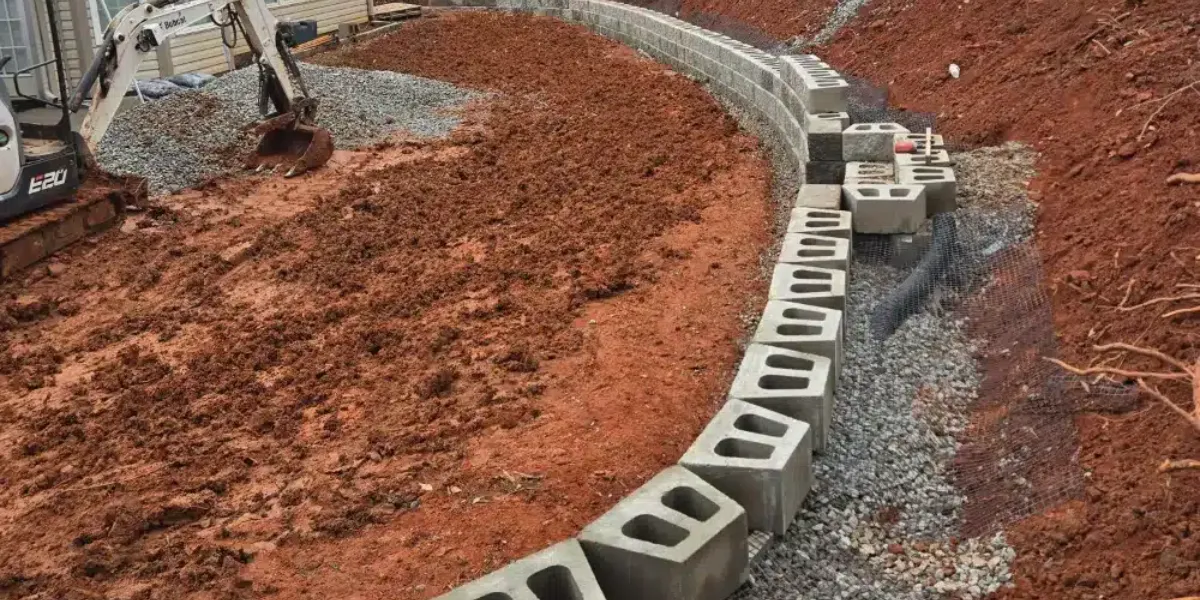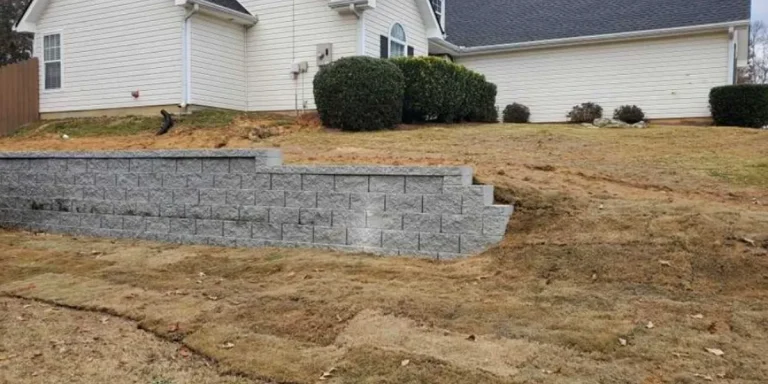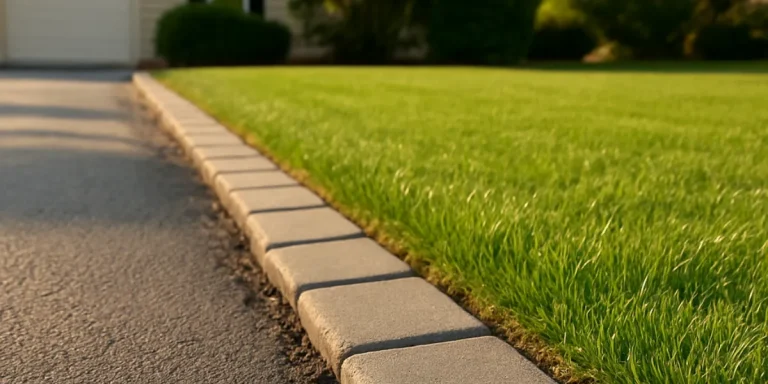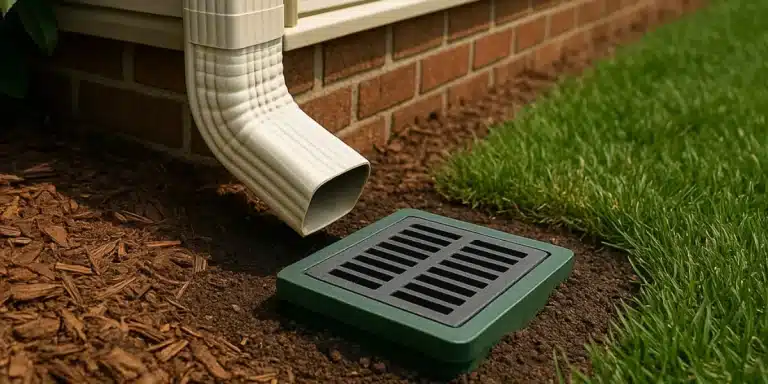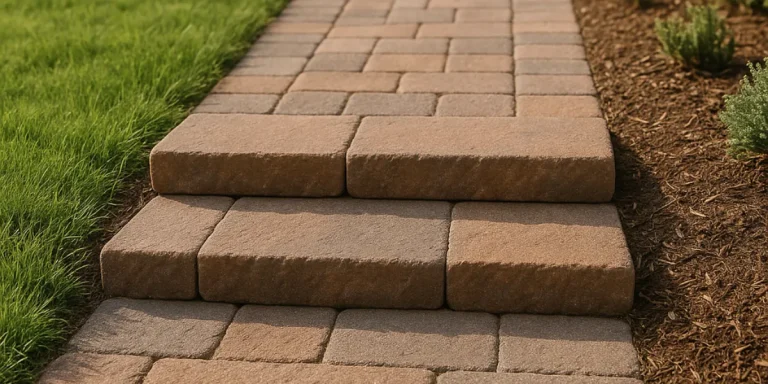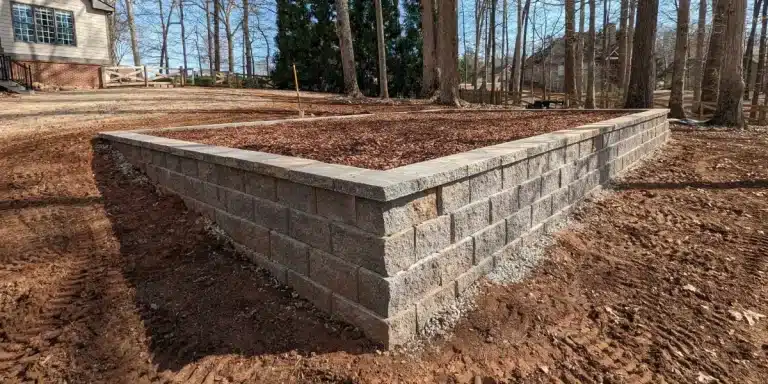How Drainage Problems Cause Retaining Walls to Collapse
A retaining wall is one of the hardest-working structures in your landscape. It prevents erosion, stabilizes slopes, and creates usable flat space for lawns, patios, or driveways. But in Gainesville’s wet, clay-heavy soils, even the strongest wall can fail if water isn’t managed properly.
At Razor Sharp Lawns, we’ve rebuilt countless retaining walls that collapsed long before their expected lifespan, all because of poor drainage. Water is the single most destructive force acting on these walls, and without the right system in place, that water quietly undermines everything holding your yard together.
This guide explains how drainage problems lead to wall failure, what warning signs to look for, and how Razor Sharp Lawns designs and builds durable retaining walls, drainage systems, and hardscaping installations that stand the test of time.
The hidden threat of trapped water
Every retaining wall has one invisible enemy: water pressure. When rain or irrigation water gets trapped behind a wall, it soaks into the soil and adds tremendous weight. This force, known as hydrostatic pressure can cause even the most solid structure to shift, lean, or collapse.
How hydrostatic pressure affects your wall:
-
- Increases the load behind the wall by thousands of pounds
- Forces the wall outward, causing cracks or bulging in the center
- Erodes the wall’s base, leading to uneven settling
- Weakens mortar joints or interlocking connections
- Traps moisture, freezing and expanding during cold weather
In Gainesville, where dense red clay holds water like a sponge, hydrostatic pressure builds faster and lasts longer than in sandy soil. That’s why nearly every retaining wall failure we repair starts with poor drainage design, or none at all.
Razor Sharp Lawns prevents these problems by designing every wall as a complete system: one that combines structure, drainage, and soil management to work with the terrain, not against it.
How poor drainage causes retaining walls to fail
When a retaining wall collapses, it’s rarely because of poor materials. In almost every case, the true cause is water. Below are the most common drainage issues that lead to early wall failure, and how we fix them the right way.
1. No dedicated drainage system
The number one cause of wall collapse is the absence of a proper drainage system. Builders may skip the drain pipe to save time or assume that gaps between blocks are enough to relieve pressure. They’re not. Without an outlet for water, the soil behind the wall becomes saturated, turning into a heavy, shifting mass that pushes relentlessly on the structure.
What happens without drainage:
-
-
- Water accumulates after every rainfall
- Soil expands, creating outward force on the wall
- The wall begins to bulge, lean, or crack
- Eventually, sections of the wall give way completely
-
At Razor Sharp Lawns, we install a perforated drain pipe at the base of every structural wall. It’s wrapped in geotextile fabric and surrounded by clean gravel to ensure continuous water flow. The pipe connects to outlet drains that release water safely away from the wall, protecting your investment from long-term pressure.
2. Wrong backfill material
Behind every retaining wall is a “drainage zone,” the space that allows water to move freely toward the drain pipe. This zone should be filled with angular gravel, not soil or clay. Unfortunately, many installers reuse the excavated soil to backfill, creating a trap for water instead of a pathway for drainage.
The consequences of improper backfill:
-
-
- Water retention increases hydrostatic pressure
- Clay expands when wet, pushing on the wall face
- Fine particles clog the drain pipe, rendering it useless
- The wall settles or shifts as saturated soil loses strength
-
Our team at Razor Sharp Lawns uses only washed, angular gravel behind every wall. This material allows water to flow easily to the drainage pipe while providing strength and compaction support. We also wrap the backfill area with filter fabric to prevent clogging and preserve long-term performance.
3. Blocked or missing outlet drains
Even if a drainage pipe is installed, it can only do its job if the water has somewhere to go. Many failed walls we inspect have pipes but no outlet or the outlet is buried, blocked, or installed too high. Without a proper release point, the system backs up and the wall begins to absorb the pressure it was meant to avoid.
Signs of blocked or missing outlets:
-
-
- Persistent water stains or dampness on the wall face
- Pools of water at the wall base after rainfall
- Gradual outward lean that worsens during wet months
-
To prevent this, Razor Sharp Lawns installs multiple outlets along longer walls and ensures each one is correctly positioned for gravity flow. We also slope the drain line to keep water moving freely.
4. Poor grading and runoff control
Proper drainage isn’t just about what’s behind the wall, it’s also about how water moves across your property. When the surrounding grade slopes toward the wall instead of away from it, every rainfall directs water exactly where it shouldn’t go. Over time, that runoff saturates the soil and overwhelms the internal drainage system.
Common grading mistakes include:
-
-
- Driveways, patios, or lawns that drain directly into the wall
- Lack of swales, trenches, or surface drains to redirect water
- Uneven slopes that allow water to pool at the wall base
-
Razor Sharp Lawns addresses these issues by evaluating the entire site, not just the wall area. We integrate solutions like French drains, channel drains, or swales to manage surface runoff, ensuring the water never overwhelms your retaining wall or nearby paver patios and hardscaping installations.
The lasting damage of drainage failure
Once drainage fails, the results are progressive and often irreversible. What starts as a minor tilt or crack can become a complete collapse if ignored.
Common signs of drainage-related wall failure:
-
-
- Horizontal cracks or bulges near the wall’s midsection
- Efflorescence or mineral deposits indicating moisture movement
- Leaning or separation between wall sections
- Erosion or washed-out soil at the base
- Drain outlets that no longer discharge water
-
When Razor Sharp Lawns rebuilds a wall that’s failed from drainage problems, we typically find the same underlying issues: no pipe, no gravel backfill, and poor grading. Our reconstruction process focuses on correcting the foundation and drainage system first ensuring the new wall is built for decades of reliable performance.
How Razor Sharp Lawns builds walls that last
Proper drainage design is at the core of every retaining wall construction project we complete. We don’t guess or take shortcuts, we build to handle Gainesville’s toughest conditions.
Our process includes:
-
- Site evaluation: We analyze soil type, slope angle, and existing water flow before excavation begins.
- Excavation and base prep: We dig deep enough for a compacted stone base that supports both structure and drainage.
- Gravel backfill installation: A continuous layer of angular stone behind the wall allows unrestricted water flow.
- Drainage pipe system: Perforated pipe wrapped in geotextile fabric directs water safely away from the wall.
- Outlet and grading setup: We finish with outlets, weep holes, and proper surface grading to control runoff.
This system is the difference between a wall that lasts a few seasons and one that lasts for generations. We apply the same drainage principles to paver patios, walkways, and driveway installations, ensuring water always moves away from your home’s structures, not toward them.
Areas We Serve
Razor Sharp Lawns proudly provides retaining wall construction, drainage installation, paver patios, and full hardscaping design services throughout Northeast Georgia, including:
• Gainesville
• Flowery Branch
• Oakwood
• Buford
• Clermont
• Murrayville
• Braselton
• Surrounding areas
We’re known across North Georgia for our precision craftsmanship, transparent communication, and durable outdoor structures that stand up to heavy rainfall, clay soils, and time.
Ready to protect your retaining wall from water damage?
Let the experts handle your drainage the right way
If your retaining wall is leaning, cracking, or showing signs of moisture damage, it’s time to call Razor Sharp Lawns. Our team specializes in retaining wall repair, drainage correction, and complete hardscaping installations designed for Gainesville’s soil and weather conditions.
We’ll inspect your property, identify the root cause of failure, and design a long-lasting solution that prevents water from ever becoming a problem again.
Call Razor Sharp Lawns today to schedule your consultation or request a free estimate.
Protect your property and restore peace of mind with a retaining wall built to handle the water it was meant to control.

